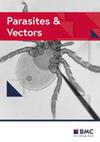马达加斯加塔那那利佛近郊的蚊虫动态及其驱动因素:多宿主单点纵向调查的启示
IF 3
2区 医学
Q1 PARASITOLOGY
引用次数: 0
摘要
马达加斯加首都塔那那利佛的人口正在稳步增长。由于该地区蚊虫载体数量众多,因此受蚊虫传播疾病影响的人口也在增加,流行病爆发的风险也在增加。本研究的目的是在资源有限的情况下,通过在多宿主单一地点进行纵向昆虫学研究,评估蚊子种群动态和疾病传播风险方面的信息。在 16 个月内(2017 年 1 月至 2018 年 4 月),在塔那那利佛的一个近郊区使用 6 个 CDC 灯光诱捕器每 15 天收集一次蚊子。以主要蚊子物种的室内和室外密度为响应变量,以月亮光照、环境数据和气候数据为解释变量,建立了多变量广义线性模型。研究共收集到 46 737 隻蚊子,分屬最少 20 個品種,其中以庫 蚊(68.9%)、五節纏繞庫蚊(19.8%)、櫛纏繞庫蚊(3.7%)和按蚊 (2.3%)最多。据观察,蚊子密度受不同滞后期的月照和气候因素相互作用的影响。室外模型显示了蚊子密度的双周和季节模式,而室内模型只显示了季节模式。塔那那利佛近郊区的蚊子种类繁多。一些众所周知的病媒物种,如西尼罗河病毒(WNV)和裂谷热病毒(RVFV)的主要病媒 Cx. antennatus、WNV 的主要病媒 Cx. quinquefasciatus、RVFV 的候选病媒 Cx. poicilipes 和疟原虫的主要病媒 An. gambiae sensu lato 都大量存在。重要的是,这四种蚊子全年都存在,尽管在寒冷的旱季它们的数量会减少,但五步蛇除外。研究发现,温度、相对湿度和降水量是影响蚊子数量的主要因素,而对于室外蚊子来说,月光也是影响蚊子数量的主要因素。确定这些驱动因素是开发病原体传播模型(R0 模型)的第一步,该模型是让公共卫生利益相关者了解病媒传播疾病最危险时期的关键。本文章由计算机程序翻译,如有差异,请以英文原文为准。
Mosquito dynamics and their drivers in peri-urban Antananarivo, Madagascar: insights from a longitudinal multi-host single-site survey
Antananarivo, the capital city of Madagascar, is experiencing a steady increase in population growth. Due to the abundance of mosquito vectors in this locality, the population exposed to mosquito-borne diseases is therefore also increasing, as is the risk of epidemic episodes. The aim of the present study was to assess, in a resource-limited setting, the information on mosquito population dynamics and disease transmission risk that can be provided through a longitudinal entomological study carried out in a multi-host single site. Mosquitoes were collected every 15 days over 16 months (from January 2017 to April 2018) using six CDC-light traps in a peri-urban area of Antananarivo. Multivariable generalised linear models were developed using indoor and outdoor densities of the predominant mosquito species as response variables and moon illumination, environmental data and climatic data as the explanatory variables. Overall, 46,737 mosquitoes belonging to at least 20 species were collected, of which Culex antennatus (68.9%), Culex quinquefasciatus (19.8%), Culex poicilipes (3.7%) and Anopheles gambiae sensu lato (2.3%) were the most abundant species. Mosquito densities were observed to be driven by moon illumination and climatic factors interacting at different lag periods. The outdoor models demonstrated biweekly and seasonal patterns of mosquito densities, while the indoor models demonstrated only a seasonal pattern. An important diversity of mosquitoes exists in the peri-urban area of Antananarivo. Some well-known vector species, such as Cx. antennatus, a major vector of West Nile virus (WNV) and Rift-Valley fever virus (RVFV), Cx. quinquefasciatus, a major vector of WNV, Cx. poicilipes, a candidate vector of RVFV and An. gambiae sensu lato, a major vector of Plasmodium spp., are abundant. Importantly, these four mosquito species are present all year round, even though their abundance declines during the cold dry season, with the exception of Cx. quinquefasciatus. The main drivers of their abundance were found to be temperature, relative humidity and precipitation, as well as—for outdoor abundance only—moon illumination. Identifying these drivers is a first step towards the development of pathogen transmission models (R0 models), which are key to inform public health stakeholders on the periods of most risk for vector-borne diseases.
求助全文
通过发布文献求助,成功后即可免费获取论文全文。
去求助
来源期刊

Parasites & Vectors
医学-寄生虫学
CiteScore
6.30
自引率
9.40%
发文量
433
审稿时长
1.4 months
期刊介绍:
Parasites & Vectors is an open access, peer-reviewed online journal dealing with the biology of parasites, parasitic diseases, intermediate hosts, vectors and vector-borne pathogens. Manuscripts published in this journal will be available to all worldwide, with no barriers to access, immediately following acceptance. However, authors retain the copyright of their material and may use it, or distribute it, as they wish.
Manuscripts on all aspects of the basic and applied biology of parasites, intermediate hosts, vectors and vector-borne pathogens will be considered. In addition to the traditional and well-established areas of science in these fields, we also aim to provide a vehicle for publication of the rapidly developing resources and technology in parasite, intermediate host and vector genomics and their impacts on biological research. We are able to publish large datasets and extensive results, frequently associated with genomic and post-genomic technologies, which are not readily accommodated in traditional journals. Manuscripts addressing broader issues, for example economics, social sciences and global climate change in relation to parasites, vectors and disease control, are also welcomed.
 求助内容:
求助内容: 应助结果提醒方式:
应助结果提醒方式:


